Features of composite piles

Composite piles are reinforced concrete structures with multiple sections, consisting of several elements that are interconnected. They create a support up to thirty-six meters long. Production conditions are stipulated in GOST 19804-2012. This set of standards was adopted in six countries of the Soviet Union, and came into force in Russia at the beginning of 2014.

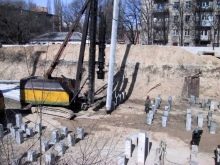
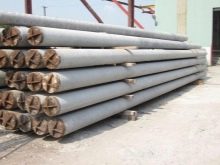
Application
Any of the reinforced concrete piles are used to support the foundation and deepen to the level of high-density soil. If the sole is not well positioned in the ground, then the foundation will not be quite stable, which will cause the soil to sink under the mass of the building.
Composite piles are used when the topsoil of a construction site is unstable: if it is thicker than the length of the piles. As a rule, it is not allowed to support the pile base on unstable soils such as peaty soil, peat bogs, fluid and highly compressible clay soil, silty soils. In the above-mentioned soils, only the pile foundation will have the stability and the necessary bearing capacity.
In addition, piles are used in the restoration of existing pile foundations, which strengthens this foundation. For this, the minimum dimensions of structures are used, consisting of five-meter sections.
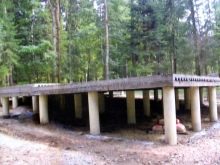
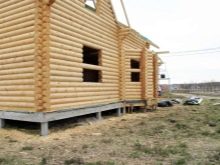
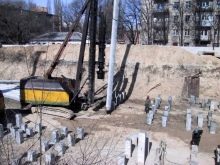
Reinforced concrete products equip pile foundations at facilities. The same structures are quite often used by construction companies that do not have a pile driver.
A standard soil pile is 12 meters long. Composite reinforced concrete piles are also used when it is impossible to use conventional piles due to geological conditions. Such piles are used, for example, in construction work carried out on the territory of Moscow, for the foundations of residential buildings, industrial buildings and various civil buildings.
The purpose of a reinforced concrete pile is to transfer vertical loads. This will avoid shrinkage of the structure during construction and operation.
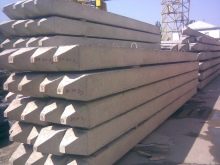

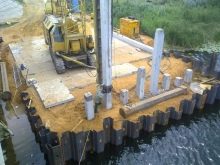
In the soil, you can use not one, but all types, provided that there is a weak layer of rock at the required depth of the soil and it is impossible to support it.
Before starting work, composite piles must undergo a static test, which will show the ability to withstand the types of load. The joints of the joints also undergo a stress test. In the construction of foundations, piles such as hanging and rack piles are used.
If it is planned to construct buildings with a subsequent increase in the dynamic load, it is better not to use composite piles for laying the foundation.
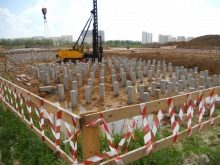
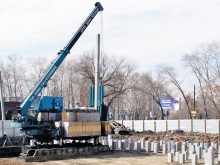
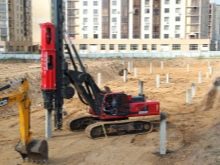
Design
Composite piles are manufactured in accordance with GOST standards. They consist of upper and lower abutting parts.
Such piles have sections such as:
- 30x30 cm - the length of such a section ranges from 14 to 24 meters;
- 35x35 cm, 40x40cm - from 14 to 28 meters.
The lengths of the mating parts may vary. In the product, the section of which is 30x30 cm, the length of the lower base is from 7 meters, which increases with each step to 12 meters; for piles with a cross section of 35x35 cm and 40x40 cm, the length of such a base is from 8 to 14 meters. As for the upper section, for a 30x30 cm pile it is within 5-12 meters, and for a 35x35 and 40x40 pile it is 6-14 meters.
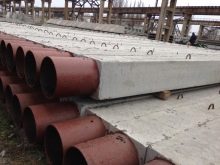
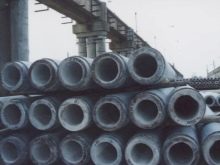
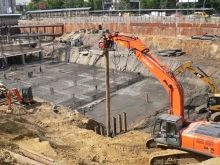
Docking is done in the following ways:
- welding connection of the insert nozzle;
- connection of sheet steel plates that squeeze the pile shaft;
- bolted connection of the crimping element;
- connection with a hinged lock;
- pin connection.
Composite piles must be reinforced with a longitudinal reinforcement cage made from a rod of class A2 and A3 with a diameter of 13-20 mm. The transverse reinforcement of the barrel is made with a metal mesh made of B-1 wire with a minimum diameter of 5 mm.
For the production of the body of the piles, heavy concrete of a class not lower than M200 is used. The filling is fine-grained crushed stone with a diameter of no more than 40 mm.
Reinforcement can be carried out using pre-tensioning technology. Before the concrete is poured into the mold, the reinforcement cage is stretched by a hydraulic jack. This manufacturing technology gives the piles maximum resistance to stress.
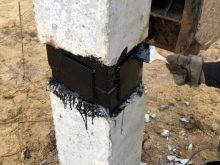

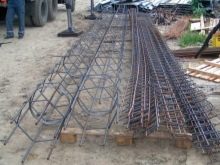
Distinctive features
A feature of this type of screw pile is the extension of the barrel length to the desired value using extension cords. The joint of two parts is represented by a rigid connection with a welding fastener.
If you follow the building technology of production, the process of lengthening the screw pile at the construction site will not affect the bearing capacity of the material, durability, strength and stability of the foundation.
This is determined by the strength of the soil and the bearing capacity of the material, which is determined by the strength of the material.
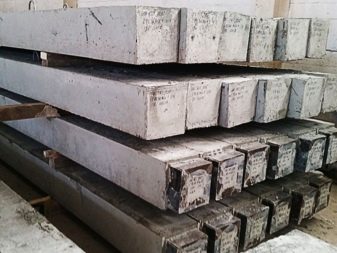
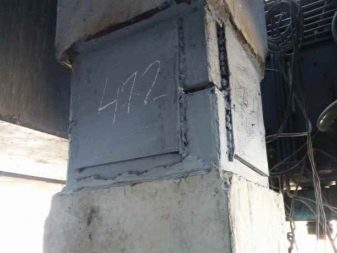
Specifications
In the table below, you will see some of the calculation results:
Piles 30 * 30 cm, length 13-24 meters | Section section 300 mm, series 1.011.1-10, issue 1 | |||||||||
Name | Length (millimeter) | Width (millimeter) | Height (millimeter) | Weight (ton) | Volume (cubic meters) | Section | Weight (t) | Volume (cubic meters) | ||
C130-SV | 13,000 | 300 | 300 | 3 | 1,2 | S50.30-Sun 16 | 1,13 | 0,45 | ||
C140-SV | 14,000 | 3,2 | 1,3 | S60.30-Sun 16 | 1,4 | 0,54 | ||||
C150-SV | 15000 | 3,4 | 1,4 | S70.30-Sun 16 | 1,6 | 0,6 | ||||
C160-SV | 16000 | 4 | 1,44 | S80.30-VSv 1/6 | 2 | 0,72 | ||||
S170-SV | 17000 | 3,8 | 1,5 | S80.30-NSv-3 | 0,73 | |||||
C180-SV | 18000 | 4,1 | 1,6 | S90.30-Sun 2,3 / 6 | 2,03 | 0,8 | ||||
S190-SV | 19000 | 4,3 | 1,7 | S100.30-Sun 2/6 | 2,3 | 0,9 | ||||
S200-SV | 20000 | 4,5 | 1,8 | C110.30-Sun 3/6 | 2,5 | 0,99 | ||||
S210-SV | 21000 | 4,7 | 1,9 | C120.30-Sun 3/6 | 3 | 1,08 | ||||
S220-SV | 22000 | 5 | 2 | С80.30-НСв. 16 | 2 | 0,73 | ||||
S230-SV | 23000 | 5,2 | 2,07 | C120.30-NSv. 3/6 | 2,7 | 1,09 | ||||
S240-SV | 24000 | 5,4 | 2,2 | |||||||
Piles 35 * 35 cm, length 13-28 meters | Section 350 mm, series 1.011.1-10, issue 1 | |||||||||
Name | Length (millimeter) | Width (millimeter) | Height (millimeter) | Weight (ton) | Volume (cubic meters) | Section | Weight (t) | Volume (cubic meters) | ||
C130-SV | 13000 | 350 | 4,03 | 1,6 | С50.35-ВСв. 2/6 | 1,6 | 0,6 | |||
C140-SV | 14000 | 4,34 | 1,7 | С60.35-ВСв. 2/6 | 1,9 | 0,7 | ||||
C150-SV | 15000 | 4,64 | 1,9 | S60.35-VSv-4 | ||||||
C160-SV | 16000 | 4,96 | 2 | S70.35-VSv. 2/6 | 2,2 | 0,9 | ||||
S170-SV | 17000 | 5,3 | 2,11 | С80.35-ВСв. 2.4 / 6 | 2,5 | 1 | ||||
C180-SV | 18000 | 5,6 | 2,23 | S90.35-VSv. 2/6 | 2,8 | 1,1 | ||||
S190-SV | 19000 | 5,9 | 2,4 | S100.35-ВСв. 2/6 | 3,08 | 1,23 | ||||
S200-SV | 20000 | 6,2 | 2,5 | С110.35-ВСв. 3/6 | 3,4 | 1,4 | ||||
S210-SV | 21000 | 6,5 | 2,6 | С120.35-ВСв. 3/6 | 3,7 | 1,5 | ||||
S220-SV | 22000 | 6,82 | 2,7 | С130.35-ВСв. 3/6 | 4 | 1,6 | ||||
S230-SV | 23000 | 7,13 | 2,9 | С140.35-ВСв. 4/6 | 4,3 | 1,7 | ||||
S240-SV | 24000 | 7,44 | 3 | S80.35-NSv. 2.4 / 6 | 2,5 | 1 | ||||
S250-SV | 25000 | 7,75 | 3,1 | C120.35-НСв. 3/6 | 4 | 1,5 | ||||
S260-SV | 26000 | 8,06 | 3,2 | C120.35-NSv-4 | 3,7 | 1,47 | ||||
S270. -SV | 27000 | 8,4 | 3,4 | С140.35-ВСв. 4/6 | 4,3 | 1,7 | ||||
S280-SV | 28000 | 8,7 | 3,5 | |||||||
Piles 40 * 40 cm, length 13-28 meters | Section section 400 mm, series 1.011.1-10, issue 1 | |||||||||
Name | Length (millimeter) | Width (millimeter) | Height (millimeter) | Weight (ton) | Volume (cubic meters) | Section | Weight (t) | Volume (cubic meters) | ||
C130-SV | 13000 | 400 | 5,2 | 2,08 | С50.40-ВСв. 2/6 | 2 | 0,8 | |||
C140-SV | 14000 | 5,6 | 2,24 | С60.40-ВСв. 2/6 | 2,4 | 1 | ||||
C150-SV | 15000 | 6 | 2,4 | С70.40-ВСв. 2/6 | 2,8 | 1,12 | ||||
C160-SV | 16000 | 6,4 | 2,6 | С80.40-ВСв. 2/6 | 3,2 | 1,3 | ||||
S170-SV | 17000 | 6,8 | 2,7 | S90.40-Sun. 3/6 | 3,6 | 1,44 | ||||
C180-SV | 18000 | 7,2 | 2,9 | S100.40-VSv. 3/6 | 4 | 1,6 | ||||
S190-SV | 19000 | 7,6 | 3,04 | С110.40-ВСв. 4/6 | 4,4 | 1,8 | ||||
S200-SV | 20000 | 8 | 3,2 | С120.40-ВСв. 4/6 | 4,8 | 2 | ||||
S210-SV | 21000 | 8,4 | 3,4 | С130.40-ВСв. 4/6 | 5,2 | 2,08 | ||||
S220-SV | 22000 | 8,8 | 3,5 | С140.40-ВСв. 5/6 | 6 | 2,24 | ||||
S230-SV | 23000 | 9 | 3,7 | S80.40-NSv. 2/6 | 3,3 | 1,3 | ||||
S240-SV | 24000 | 9,6 | 3,8 | C120.40-НСв. 4/6 | 4,9 | 1,94 | ||||
S250-SV | 25000 | 10 | 4 | C140.40-НСв. 5/6 | 5,7 | 2,3 | ||||
S260-SV | 26000 | 10,4 | 4,2 | |||||||
S270-SV | 27000 | 11 | 4,3 | |||||||
S280-SV | 28000 | 11,2 | 4,5 | |||||||
Types and marking
According to the provisions of GOST, the following types of composite products are distinguished:
- piles with a solid quadratic section;
- hollow piles with a circular cross section;
- shell piles.
Composite piles have unified markings like С260.35. SV, where:
- C - reinforced concrete pile with a solid square section;
- 260 - length of all composite sections in decimeters;
- 35 - section of the trunk in centimeters;
- CB - connection type.
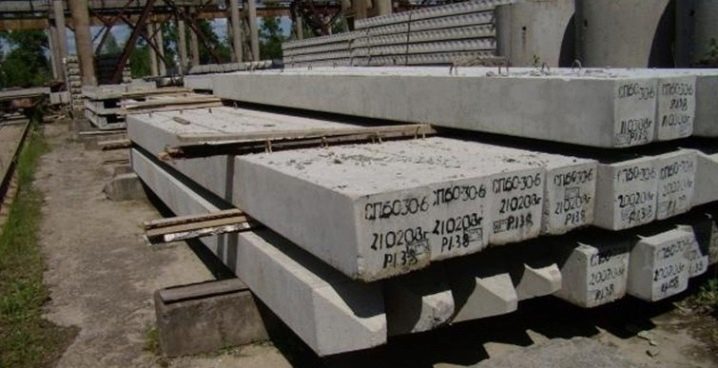
Immersion technique
Composite piles are driven into the ground by impact driving, which is carried out using a diesel or hydraulic hammer. In no case should vibrators be used when connecting, since the mating parts under such influence are deformed and become unsuitable for operation.
Driving technology takes place in the following order:
- slinging the lower part, then setting the barrel in an upright position to the place of hammering;
- the head of the pile must be brought under the head of the pile driving hammer, which is equipped with a support element that prevents deformation during driving;
- alignment of the vertical position, centering of the axis and its relation to the axis of the striking part of the diesel hammer;
- initial strikes should be carried out at a power of 20-25%, which is necessary for correct positioning at the first stage of the dive;
- after the pile reaches 1.5-5 meters, driving occurs at full power until the head of the section is 30-50 cm higher than the ground;
- the second section joins the one already driven into the ground (accuracy of movement is required here);
- the joint of the mortgage nozzles is fastened by electric arc welding, after which the composite pile is driven.
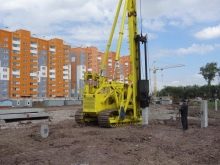
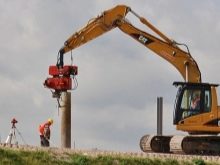
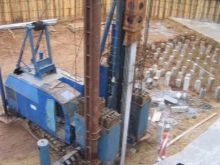
Upon completion, it is necessary to protect the welded seam with anti-corrosion Kuzbasslak - coal-tar varnish.
Driven pile foundations require enormous metal consumption. However, this disadvantage can be easily eliminated if more prestressed piles without transverse reinforcement are used, if not with final replacement.
For denser and stronger soils, piles with a collet connection are used. At the bottom junction, a sleeve is concreted with a socket at the end, muffled by a plate.
The strength in the place of the collet connection increases the strength of the entire pile, but it also has limitations:
- collet joint capacity should not exceed 60 tons;
- Collet piles can only be used in a "hanging" state - limited by soil conditions.
Driving a composite pile - in the next video.













The comment was sent successfully.